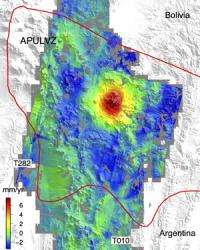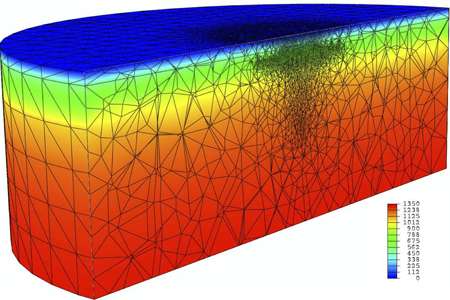Researchers ID unique geological 'sombrero' uplift in South America

(Phys.org)—Scientists at Scripps Institution of Oceanography at UC San Diego have used 20 years of satellite data to reveal a geological oddity unlike any seen on Earth.
At the border of Argentina, Bolivia and Chile sits the Altiplano-Puna plateau in the central Andes region, home to the largest active magma body in Earth's continental crust and known for a long history of massive volcanic eruptions. A study led by Yuri Fialko of Scripps and Jill Pearse of the Alberta Geological Survey has revealed that magma is forming a big blob in the middle of the crust, pushing up the earth's surface across an area 100 kilometers (62 miles) wide, while the surrounding area sinks, leading to a unique geological phenomenon in the shape of a Mexican hat that the researchers have described as the "sombrero uplift."
Since the magma motion is happening at a great depth and at a fairly slow rate—the earth's surface rises at about a centimeter per year or roughly the rate fingernails grow—there is no immediate danger of a volcanic outpouring, the researchers said.
The details of the study, which was funded by the National Science Foundation, are published in the October 12 issue of the journal Science.
"It's a subtle motion, pushing up little by little every day, but it's this persistence that makes this uplift unusual. Most other magmatic systems that we know about show episodes of inflation and deflation," said Fialko, a professor of geophysics in the Cecil H. and Ida M. Green Institute of Geophysics and Planetary Physics at Scripps.
The researchers have attributed the observed steady motion and sombrero-shaped deflection of the earth's surface to a large blob of magma, called a "diapir" in geological terms, forming on top of the Altiplano-Puna magma body. Diapirs have been studied using geologic records in rocks frozen many millions of years ago, but the new study is the first to identify an active magma diapir rising through the crust at present day.
Fialko said a similar uplift phenomenon is occurring near Socorro, New Mexico, but at a much lower rate.

"Satellite data and computer models allowed us to make the important link between what's observed at the surface and what's happening with the magma body at depth," said Fialko.
Fialko said the sombrero uplift could provide insights into the initial stages of massive magmatic events leading to the formation of large calderas. Such "super-volcano" events erupt thousands of cubic kilometers of magma into the atmosphere and can affect local and global climates. Compared with the Icelandic volcano eruption in 2011 that spewed large amounts of ash into the atmosphere and disrupted global air travel, Fialko said, a super-volcano event would be thousands of times greater.
"Those were truly disaster-type events," said Fialko. "Fortunately such events haven't happened in human history, but we know they did happen in the Altiplano-Puna area in the past."
More information: "Sombrero Uplift Above the Altiplano-Puna Magma Body: Evidence of a Ballooning Mid-Crustal Diapir," by Y. Fialko, Science, 2012.
Journal information: Science
Provided by University of California - San Diego
















